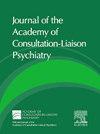Clinical Utility and Performance of the Traditional Chinese Version of the 4-As Test for Delirium due to Traumatic Brain Injury
IF 2.5
4区 心理学
Q2 PSYCHIATRY
Journal of the Academy of Consultation-Liaison Psychiatry
Pub Date : 2025-03-01
DOI:10.1016/j.jaclp.2024.12.005
引用次数: 0
Abstract
Background
Delirium is a common symptom following a traumatic brain injury that is often overlooked by healthcare professionals. Early detection of posttraumatic delirium is crucial to improving patient outcomes and quality of life. The 4 As Test (4AT: alertness, attention, abbreviated mental test-4, and acute mental changes) is a brief and rapid tool for delirium assessment with acceptable reliability and validity. However, the 4AT has not yet been translated for use in the Taiwanese population.
Objective
To translate the 4AT into Traditional Chinese (TC-4AT), assess its reliability and validity, and explore the clinical effects of delirium in patients with a traumatic brain injury.
Methods
This prospective observational study was conducted at the neurosurgery wards of 2 Taiwanese hospitals. Patients who were aged 20 years or older, were diagnosed with a traumatic brain injury, and had a Glasgow Coma Scale score between 13 and 15 were included. Interrater reliability was assessed, and validity was verified using criterion-related comparisons with the Short Confusion Assessment Method. The Diagnostic and Statistical Manual of Mental Disorders, Fifth Edition criteria were employed to assess the sensitivity and specificity of the TC-4AT for screening posttraumatic brain injury delirium.
Results
A total of 100 patients with an average age of 67 years were enrolled, of whom 10% were diagnosed with delirium based on the Diagnostic and Statistical Manual of Mental Disorders, Fifth Edition criteria. The interrater reliability of the TC-4AT was 1.00. Patients with delirium tended to have a longer hospital stay than those without delirium (13 days vs. 7 days) although the difference was nonsignificant (P = 0.28). In terms of criterion validity, patients diagnosed with delirium using the Short Confusion Assessment Method had a significantly higher score on the TC-4AT than those not diagnosed with delirium (P < 0.001). The receiver operating characteristic curve indicated that the optimal cutoff point was 4, with sensitivity, specificity, and area under the characteristic curve of 0.90, 0.94, and 0.96, respectively.
Conclusion
The TC-4AT is an accurate tool for delirium assessment that aids early detection and in informed decision-making in preventive care.
脑外伤谵妄的中医4-As测试的临床应用与表现。
背景:谵妄是创伤性脑损伤后的常见症状,经常被卫生保健专业人员所忽视。早期发现创伤后谵妄对改善患者预后和生活质量至关重要。4as测试(4AT:警觉性、注意力、简短精神测试-4和急性精神变化)是评估谵妄的一种简单、快速的工具,信度和效度可接受。然而,4AT尚未被翻译为在台湾人口中使用。目的:将4AT量表(TC-4AT)翻译成中文,评估其信效度,探讨外伤性脑损伤患者谵妄的临床疗效。方法:本前瞻性观察研究在台湾2家医院的神经外科病房进行。年龄在20岁或以上,被诊断为创伤性脑损伤,格拉斯哥昏迷量表评分在13到15之间的患者被包括在内。评估了判读者的信度,并使用与短混淆评估法相关的标准比较验证了效度。采用《精神障碍诊断与统计手册》第五版标准评估TC-4AT筛查创伤后脑损伤谵妄的敏感性和特异性。结果:共纳入100例患者,平均年龄67岁,其中10%根据《精神障碍诊断与统计手册》第五版标准诊断为谵妄。TC-4AT的互译信度为1.00。谵妄患者比非谵妄患者住院时间更长(13天比7天),但差异无统计学意义(P = 0.28)。在标准效度方面,使用短混淆评估法诊断为谵妄的患者在TC-4AT上的得分明显高于未诊断为谵妄的患者(P结论:TC-4AT是一种准确的谵妄评估工具,有助于早期发现和预防护理的知情决策。
本文章由计算机程序翻译,如有差异,请以英文原文为准。
求助全文
约1分钟内获得全文
求助全文
来源期刊

Journal of the Academy of Consultation-Liaison Psychiatry
Psychology-Clinical Psychology
CiteScore
5.80
自引率
13.00%
发文量
378
审稿时长
50 days
 求助内容:
求助内容: 应助结果提醒方式:
应助结果提醒方式:


